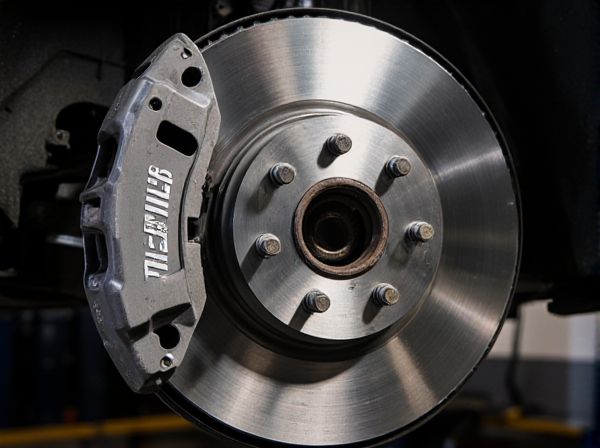
Photo illustration: Organic Pads vs Carbon Fiber Pads
Organic brake pads offer quieter operation and better initial bite, making them ideal for everyday driving and wet conditions. Carbon fiber pads provide superior heat resistance and longer lifespan, excelling in high-performance and racing scenarios. Your choice depends on whether you prioritize smooth, low-noise braking or enhanced durability and performance under extreme conditions.
Table of Comparison
| Feature | Organic Brake Pads | Carbon Fiber Brake Pads |
|---|---|---|
| Material Composition | High-quality organic fibers, resins, and fillers | Carbon fibers bonded with resin matrix |
| Performance | Good stopping power at low to moderate speeds | Superior stopping power, ideal for high-performance use |
| Heat Resistance | Moderate heat resistance; may fade under heavy braking | High heat resistance; stable performance in extreme conditions |
| Durability | Moderate lifespan; wears faster under aggressive use | Long-lasting; maintains integrity under stress |
| Noise Level | Generally quiet operation | May produce slight noise at high temperatures |
| Dust Generation | Produces more brake dust | Low dust, cleaner wheels |
| Cost | Economical and affordable | Higher cost; premium pricing |
| Best Use | Daily driving, City use, light braking demands | Sports cars, Performance driving, Racing applications |
Introduction to Brake Pad Materials
Organic brake pads consist of natural fibers, resins, and fillers, offering quieter braking and less rotor wear, suitable for everyday driving. Carbon fiber brake pads deliver superior heat resistance, enhanced stopping power, and durability, making them ideal for high-performance and racing applications. Understanding the distinct properties of these materials helps choose the right brake pads for specific driving needs and conditions.
Overview of Organic Brake Pads
Organic brake pads consist of a blend of fibers, fillers, and binding resins designed to provide smooth and quiet braking performance. They generate less brake dust and are gentler on rotors, making them ideal for everyday driving and light-duty applications. While they may wear faster than carbon fiber pads, organic pads offer reliable stopping power and improved comfort under normal conditions.
Overview of Carbon Fiber Brake Pads
Carbon fiber brake pads offer superior heat dissipation and consistent performance under extreme conditions compared to organic pads. Their composite material structure provides enhanced durability and reduced brake fade, making them ideal for high-performance and racing applications. These pads also maintain effective braking power over a broader temperature range, resulting in improved safety and control.
Performance Comparison: Organic vs Carbon Fiber Pads
Organic brake pads deliver smooth and quiet braking with excellent initial bite, ideal for daily driving and light performance use. Carbon fiber pads offer superior heat dissipation, higher friction stability, and consistent performance under extreme conditions, making them suitable for high-performance and racing applications. While organic pads provide better modulation and less rotor wear, carbon fiber pads excel in durability and fade resistance during aggressive braking.
Durability and Longevity
Organic brake pads offer moderate durability and typically last between 20,000 to 40,000 miles, making them suitable for everyday driving with quieter operation but faster wear under high-stress conditions. Carbon fiber pads provide superior longevity and withstand higher temperatures, often exceeding 40,000 miles, ideal for performance vehicles needing consistent braking power with reduced fade. The advanced composite materials in carbon fiber pads enhance heat dissipation and structural integrity, significantly extending their lifespan compared to organic alternatives.
Noise and Comfort Factors
Organic brake pads generate less noise due to their softer compound, providing a quieter braking experience compared to carbon fiber pads, which tend to produce higher-pitched sounds under heavy use. Comfort is enhanced with organic pads as they offer smoother engagement and reduced vibration, reducing brake judder during stops. Carbon fiber pads excel in high-performance scenarios but may sacrifice some noise reduction and comfort for increased durability and heat resistance.
Cost Differences and Value
Organic brake pads generally cost less upfront than carbon fiber pads due to their simpler materials and manufacturing processes, making them a budget-friendly choice for everyday driving. Carbon fiber pads, while significantly more expensive, offer superior durability and performance, often lasting longer and providing better heat resistance, which can translate into long-term value for high-performance applications. Choosing between the two depends on balancing initial cost against longevity and performance demands, with carbon fiber pads delivering greater value for aggressive drivers despite the higher price.
Environmental Impact Considerations
Organic brake pads are made from natural materials such as rubber, resins, and fibers, resulting in lower environmental toxicity and easier biodegradability compared to carbon fiber pads composed of synthetic carbon composites. Carbon fiber pads offer longer lifespan and higher performance but involve energy-intensive manufacturing processes and generate microplastics that linger in ecosystems, raising concerns about long-term pollution. Choosing organic pads reduces carbon footprint and environmental contamination during production and disposal, aligning with eco-friendly automotive practices.
Ideal Applications for Each Type
Organic brake pads excel in everyday driving scenarios due to their smooth braking performance and low noise, making them ideal for city commuting and light-duty vehicles. Carbon fiber pads perform best under high-temperature conditions and intense braking, such as in racing or high-performance sports cars, where superior heat dissipation and durability are critical. Choosing between organic and carbon fiber pads depends on the vehicle's use case, with organic suited for comfort and carbon fiber optimized for aggressive driving and track use.
Conclusion: Choosing the Right Brake Pad
Selecting the right brake pad depends on vehicle use and performance needs; organic pads offer quieter operation and better initial bite ideal for daily driving, while carbon fiber pads provide superior heat resistance and durability suitable for high-performance or racing conditions. Organic pads tend to wear faster and produce less brake dust, contributing to lower maintenance, whereas carbon fiber pads excel in aggressive driving with consistent stopping power at higher temperatures. Evaluating driving style, environment, and budget ensures the optimal balance between comfort, longevity, and braking efficiency.
 caratoz.com
caratoz.com